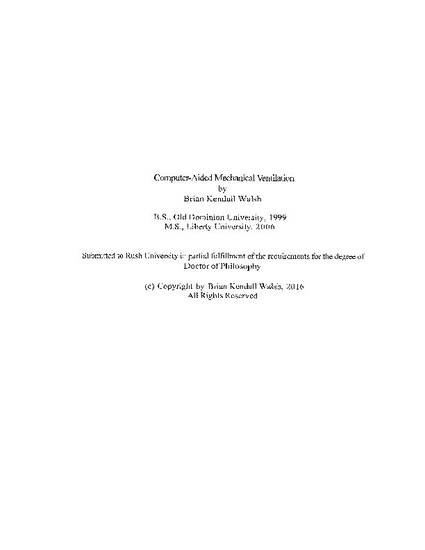
Dissertation
Computer-Aided Mechanical Ventilation
(2016)
Abstract
Statement of the problem: The systematic implementation of evidence-based practice through the use of guidelines, checklists and protocols has been shown to mitigate the risks associated with MV, yet variation in practice remains prevalent. Recent advances in MV, physiologic monitoring, device-to-device communication, computer processing and software engineering have allowed for the development of an automated point-of-care access to real-time goal setting and practice variance identification. Our aim was to assess the utility of a computer-aided MV (CAMV) system that displays variances and scores the overall MV course. Methods: A retrospective categorization of the ventilation and oxygenation statuses of patients within our pediatric intensive care unit (PICU) over a 2 ½ years period utilizing 15 rule-based algorithms was initiated as a proof of concept. Goals were predetermined based on generally accepted values. All patient categories were calculated and presented as a percent of recording time. Following the feasibility study, a retrospective observational study (baseline), followed by two sequential interventions made over a 2-month period was conducted. Phase I comprised a survey of goals of MV by clinicians caring for patients being monitored by the CAMV system. Phase II intervention was the setting and monitoring of goals of MV with a web browser based data visualization system (T3). An outcome measurement tool was developed to score each MV course. The MV score (MVS) evaluated four outcomes: (1) acceptable ventilation, (2) acceptable oxygenation, (3) barotrauma free and (4) volutrauma-free states as a percent of recording time. Results: Pilot consisted of 222 patients. The Baseline phase evaluated 130 patients, Phase I enrolled 31 patients and Phase II enrolled 36 patients. There were no differences in demographic characteristics between cohorts. One hundred and seventy-one surveys were completed in Phase I. An increase in the use of T3 by 87% was observed in Phase II from Phase I. MVS improved by 8.4% in Phase I and 11.3% in Phase II from Baseline. The largest improvement was in the volutrauma-free category. MVS was 9% higher on average in those who survived. Conclusion: The use of CAMV was associated with an improvement in MVS. Further research is needed to determine if improvements in MVS through a targeted, process-oriented intervention such as CAMV will lead to improved patient outcomes.
Keywords
- mechanical ventilation,
- quality of care,
- guidelines,
- checklist,
- protocols,
- decision support
Disciplines
Publication Date
Spring March, 2016
Degree
Doctor of Philosophy (PhD)
Field of study
Health Sciences
Department
The Graduate College
Advisors
Robert Kacmarek, PhD, RRT; Ron Beckett, PhD, RRT; John H. Arnold, MD; Ellen A. Becker, PhD, RRT; Douglas Kuperman, PhD, RRT
Citation Information
Brian Walsh. "Computer-Aided Mechanical Ventilation" (2016) Available at: http://works.bepress.com/brian-walsh/10/
